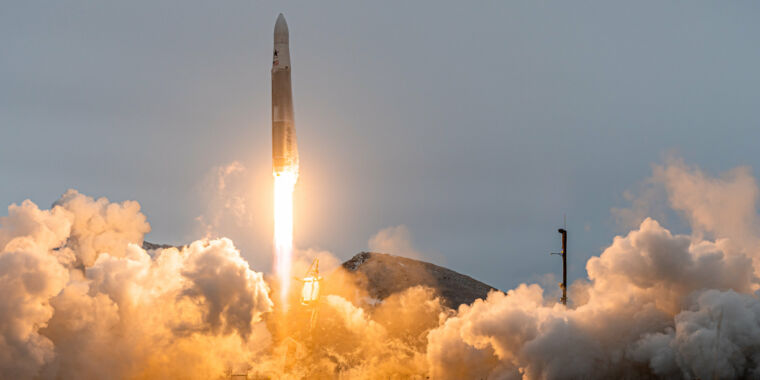
-
Rocket 3.2 takes off on Tuesday afternoon.John Kraus for Astra
-
The company's launch site is based in Kodiak, Alaska.John Kraus for Astra
-
Astra set up this launch with just five people in Alaska.John Kraus for Astra
-
During this flight, the rocket nearly reached orbit.John Kraus for Astra
-
The upper stage reached an apogee of 390km.Astra
-
This was Astra's second orbital launch attempt.John Kraus for Astra
-
Saturn and Jupiter in conjunction above Rocket 3.2.John Kraus for Astra
If we're being honest, Astra's first orbital launch attempt in September was just not all that impressive. Within 10 or 15 seconds of launching, Rocket 3.1 began to veer off course, and it had to be commanded to shut down before it flew out of its safety corridor.
After the flight, Astra's leaders put a brave face on the short mission, saying they were "pretty pleased" with the rocket's performance, and they thought they were dealing with a software problem rather than a hardware one. Even so, it did not exactly instill confidence in the four-year-old company. The COVID-19 pandemic was starting to flare back up across the world, fundraising was tight in the industry, and it seemed like Astra may still have a very long way to go before getting into space.
Amid these dark times, however, Astra's team of about 100 employees put their heads down and their masks on and plowed forward. In doing so, they worked something of a miracle, readying Rocket 3.2 and getting it to the company's launch site in Alaska in fewer than three months.
This in and of itself is a rather notable achievement. Compared to other commercially developed small rockets, three months is a blink of an eye. Northrop Grumman took 15 months between the flight of its first and second Pegasus rockets; SpaceX needed a year between the first two Falcon 1 missions; and Rocket Lab required eight months between its first and second Electron flights.
Poor weather prevented launch attempts on Friday and through the weekend, but by Tuesday, the upper-level winds over the spaceport in Kodiak, Alaska, lessened. By 12:55pm local time, conditions were acceptable despite the leaden skies overhead, and the rocket with its five main engines roared to life.
This time, there were no issues with the rocket's ascent. It followed its flight trajectory nearly dead on. A couple of minutes into flight, the main engines shut down, and the second stage separated. Its engine, too, lit. This upper stage then burnt all of its propellant and simulated the deployment of a payload into space.
Alas, Rocket 3.2 did not reach orbit. The company had not quite gotten the mixture of kerosene to oxidizer correct—something that is difficult to test on the ground—and wound up with an excess of liquid oxygen. Had the upper stage burnt kerosene for a few more seconds, the upper stage would have reached orbit. As it was, the booster peaked at an apogee of 390km above the Earth's surface.
"It's really hard for us to process the outcome here," admitted Chris Kemp, the chief executive of Astra and the company's co-founder, during a call with reporters. While he said the company was still able to raise money during the pandemic, he admitted this successful flight would unlock contracts and allow Astra more access to less expensive capital. "It's a really nice Christmas present for the team as we go into the holidays," he said.
Taking the next step
The company's next booster, Rocket 3.3, is already 75 percent complete, Kemp said. Based on an initial review of Tuesday's flight, this rocket will not need any major hardware or software changes. Instead, the company will tweak the fuel mixture in the upper stage to provide the performance needed to put a small payload into orbit. He would not say how large a payload Rocket 3.3 was likely to be able to accommodate. However, Astra has a customer for the mission, and it will be launched in "a few months." It has customers for more than a dozen missions and now expects to sign more.
Astra was founded to provide rapid, low-cost access to space for small satellites. The quick turnaround between its first and second flights suggests it may make good on this promise. It's impressive, too, that the company needs just five people to set up its launch site. At Kodiak, Astra has a concrete pad and a tent. A week before launching the rocket, its launcher, propellant, and other equipment arrived in four shipping containers from California. A team of five set the launch system up, and employees back at Astra's headquarters in Alameda, California, controlled the launch through cloud computing.
This flexible approach to launch, requiring a minimal amount of infrastructure, is the kind of thing the US Defense Advanced Research Projects Agency sought to foster through its launch challenge. The competition ended earlier this year without a winner, but Astra came closest to claiming the prize.
"I'm happy to see Astra achieve most of their goals with this flight after watching their team put in a lot of hard work," said Todd Master, who managed the launch challenge for DARPA. "A diversity of launch vehicles with a range of capability and prices portends interesting possibilities for future Department of Defense uses."
Listing image by John Kraus for Astra
Article From & Read More ( Astra set up a rocket launch with five people and came within seconds of orbit - Ars Technica )https://ift.tt/3nrpnua
Science
No comments:
Post a Comment